The Interactions between Ionic Liquids and Lithium Polysulfides in Lithium–Sulfur Batteries: A Systematic Density Functional Theory Study
Abstract
1. Introduction
2. Computational Methods
2.1. Theoretical Methods
2.2. Study of the Dimeric Interactions
2.3. Study of the Trimeric Interactions
3. Results and Discussion
3.1. Structures and Energetics of the Complexes Containing Different Interactions
3.2. Interaction Analysis
3.2.1. Atoms in Molecules (AIM) Analyses
3.2.2. Independent Gradient Model Based on Hirshfeld Partition (IGMH) Analyses
3.3. Electron Transfer Analysis
3.3.1. Electron Density Difference (EDD) Analyses
3.3.2. Charge Decomposition Analysis (CDA)
3.4. Energy Decomposition Analysis
3.5. Comparison with the Experimental Findings
4. Conclusions
Supplementary Materials
Author Contributions
Funding
Institutional Review Board Statement
Informed Consent Statement
Data Availability Statement
Conflicts of Interest
References
- Yang, Q.; Zhang, Z.; Sun, X.G.; Hu, Y.S.; Xing, H.; Dai, S. Ionic liquids and derived materials for lithium and sodium batteries. Chem. Soc. Rev. 2018, 47, 2020–2064. [Google Scholar] [CrossRef]
- Watanabe, M.; Thomas, M.L.; Zhang, S.; Ueno, K.; Yasuda, T.; Dokko, K. Application of Ionic Liquids to Energy Storage and Conversion Materials and Devices. Chem. Rev. 2017, 117, 7190–7239. [Google Scholar] [CrossRef]
- Tatara, R.; Ueno, K.; Dokko, K.; Watanabe, M. Thermodynamic Effect of Anion Activity on Electrochemical Reactions Involving Li+ Ions in Room-Temperature Ionic Liquids. ChemElectroChem 2019, 6, 4444–4449. [Google Scholar] [CrossRef]
- Zhang, S.; Lu, Y.; Peng, C.; Liu, H.; Jiang, D.-E. Structure and Interaction of Ionic Liquid Monolayer on Graphite from First-Principles. J. Phys. Chem. C 2018, 123, 618–624. [Google Scholar] [CrossRef]
- Pilar, K.; Rua, A.; Suarez, S.N.; Mallia, C.; Lai, S.; Jayakody, J.R.P.; Hatcher, J.L.; Wishart, J.F.; Greenbaum, S. Investigation of dynamics in BMIM TFSA ionic liquid through variable temperature and pressure NMR relaxometry and diffusometry. J. Electrochem. Soc. 2017, 164, H5189–H5196. [Google Scholar] [CrossRef]
- Cai, Y.; Xu, T.; Meng, X.; von Solms, N.; Zhang, H.; Thomsen, K. Formation of robust CEI film on high voltage LiNi0.6Co0.2Mn0.2O2 cathode enabled by functional [PIVM][TFSA] ionic liquid additive. Electrochim. Acta 2022, 424, 140679. [Google Scholar] [CrossRef]
- Roy, B.; Pal, U.; Kar, M.; MacFarlane, D.R. Recent strategies for improving the performance of ionic liquids as battery electrolytes. Curr. Opin. Green Sustain. Chem. 2022, 37, 100676. [Google Scholar] [CrossRef]
- Ray, A.; Saruhan, B. Application of Ionic Liquids for Batteries and Supercapacitors. Materials 2021, 14, 2942. [Google Scholar] [CrossRef] [PubMed]
- Xu, X.; Su, L.; Lu, F.; Yin, Z.; Gao, Y.; Zheng, L.; Gao, X. Unraveling anion effect on lithium ion dynamics and interactions in concentrated ionic liquid electrolyte. J. Mol. Liq. 2022, 361, 119629. [Google Scholar] [CrossRef]
- Penley, D.; Vicchio, S.P.; Getman, R.B.; Gurkan, B. Energetics of Li+ Coordination with Asymmetric Anions in Ionic Liquids by Density Functional Theory. Front. Energy Res. 2021, 9, 725010. [Google Scholar] [CrossRef]
- Lu, Y.; Tian, Y.; Xu, Z.; Liu, H. Interfacial structures and decomposition reactions of hybrid anion-based ionic liquids at lithium metal surface from first-principles and ab initio molecular dynamics. J. Mol. Liq. 2022, 366, 120232. [Google Scholar] [CrossRef]
- Chidiac, J.; Timperman, L.; Anouti, M. Small dissymmetry, yet large effects on the transport properties of electrolytes based on imide salts: Consequences on performance in Li-ion batteries. J. Energy Chem. 2022, 65, 352–366. [Google Scholar] [CrossRef]
- Chidiac, J.; Timperman, L.; Anouti, M. Role of FTFSI Anion Asymmetry on Physical Properties of AFTFSI (A=Li, Na and K) Based Electrolytes and Consequences on Supercapacitor Application. ChemPhysChem 2021, 22, 1863–1879. [Google Scholar] [CrossRef] [PubMed]
- Reber, D.; Takenaka, N.; Kuhnel, R.S.; Yamada, A.; Battaglia, C. Impact of Anion Asymmetry on Local Structure and Supercooling Behavior of Water-in-Salt Electrolytes. J. Phys. Chem. Lett. 2020, 11, 4720–4725. [Google Scholar] [CrossRef]
- Palumbo, O.; Appetecchi, G.B.; Maresca, G.; Brubach, J.-B.; Roy, P.; Di Muzio, S.; Trequattrini, F.; Bordignon, D.; Legrand, F.; Falgayrat, A.; et al. Synthesis, Physical Properties and Electrochemical Applications of Two Ionic Liquids Containing the Asymmetric (Fluoromethylsulfonyl)(Trifluoromethylsulfonyl)imide Anion. Appl. Sci. 2022, 12, 4524. [Google Scholar] [CrossRef]
- Jeong, S.; Li, S.; Appetecchi, G.B.; Passerini, S. Asymmetric ammonium-based ionic liquids as electrolyte components for safer, high-energy, electrochemical storage devices. Energy Storage Mater. 2019, 18, 1–9. [Google Scholar] [CrossRef]
- Gunderson-Briggs, K.E.; Ruther, T.; Best, A.S.; Kar, M.; Forsyth, C.; Izgorodiana, E.I.; MacFarlane, D.R.; Hollenkamp, A.F. A Hybrid Anion for Ionic Liquid and Battery Electrolyte Applications: Half Triflamide, Half Carbonate. Angew. Chem. Int. Ed. Engl. 2019, 58, 4390–4394. [Google Scholar] [CrossRef] [PubMed]
- Zhang, Z.; Zhang, P.; Liu, Z.; Du, B.; Peng, Z. A Novel Zwitterionic Ionic Liquid-Based Electrolyte for More Efficient and Safer Lithium-Sulfur Batteries. ACS Appl. Mater. Interfaces 2020, 12, 11635–11642. [Google Scholar] [CrossRef]
- Ren, W.; Ma, W.; Zhang, S.; Tang, B. Recent advances in shuttle effect inhibition for lithium sulfur batteries. Energy Storage Mater. 2019, 23, 707–732. [Google Scholar] [CrossRef]
- Li, H.; Ma, S.; Li, J.; Liu, F.; Zhou, H.; Huang, Z.; Jiao, S.; Kuang, Y. Altering the reaction mechanism to eliminate the shuttle effect in lithium-sulfur batteries. Energy Storage Mater. 2020, 26, 203–212. [Google Scholar] [CrossRef]
- Li, L.; Chen, X.; Huang, Y.; Zhang, P.; Zhou, D.; Zhang, G.; Xiao, B. Double-active-site enables 2D B2S and B2S3 catalyst with suppressed shuttle effect and improved polysulfides redox kinetics in lithium-sulfur batteries: A first-principles study. Appl. Surf. Sci. 2022, 602, 154295. [Google Scholar] [CrossRef]
- Li, H.; Meng, R.; Guo, Y.; Ye, C.; Kong, D.; Johannessen, B.; Jaroniec, M.; Qiao, S.Z. Unraveling the Catalyst-Solvent Interactions in Lean-Electrolyte Sulfur Reduction Electrocatalysis for Li-S Batteries. Angew. Chem. Int. Ed. Engl. 2022, 61, e202213863. [Google Scholar] [CrossRef]
- Zhou, L.; Danilov, D.L.; Qiao, F.; Wang, J.; Li, H.; Eichel, R.A.; Notten, P.H.L. Sulfur Reduction Reaction in Lithium–Sulfur Batteries: Mechanisms, Catalysts, and Characterization. Advanced Energy Materials 2022, 12, 2202094. [Google Scholar] [CrossRef]
- Feng, S.; Fu, Z.H.; Chen, X.; Li, B.Q.; Peng, H.J.; Yao, N.; Shen, X.; Yu, L.; Gao, Y.C.; Zhang, R.; et al. An Electrocatalytic Model of the Sulfur Reduction Reaction in Lithium-Sulfur Batteries. Angew. Chem. Int. Ed. Engl. 2022, 61, e202211448. [Google Scholar] [CrossRef]
- Xiong, S.; Xie, K.; Diao, Y.; Hong, X. Properties of surface film on lithium anode with LiNO3 as lithium salt in electrolyte solution for lithium–sulfur batteries. Electrochim. Acta 2012, 83, 78–86. [Google Scholar] [CrossRef]
- Zhang, S.S. Role of LiNO3 in rechargeable lithium/sulfur battery. Electrochim. Acta 2012, 70, 344–348. [Google Scholar] [CrossRef]
- Liang, X.; Wen, Z.; Liu, Y.; Wu, M.; Jin, J.; Zhang, H.; Wu, X. Improved cycling performances of lithium sulfur batteries with LiNO3-modified electrolyte. J. Power Sources 2011, 196, 9839–9843. [Google Scholar] [CrossRef]
- Aurbach, D.; Pollak, E.; Elazari, R.; Salitra, G.; Kelley, C.S.; Affinito, J. On the surface chemical aspects of very high energy density, rechargeable Li–sulfur batteries. J. Electrochem. Soc. 2009, 156, A694. [Google Scholar] [CrossRef]
- Mukra, T.; Horowitz, Y.; Shekhtman, I.; Goor, M.; Drvarič Talian, S.; Burstein, L.; Kasnatscheew, J.; Meister, P.; Grünebaum, M.; Winter, M.; et al. Disiloxane with nitrile end groups as Co-solvent for electrolytes in lithium sulfur batteries—A feasible approach to replace LiNO3. Electrochim. Acta 2019, 307, 76–82. [Google Scholar] [CrossRef]
- Chung, S.H.; Manthiram, A. Current status and future prospects of metal–sulfur batteries. Adv. Mater. 2019, 31, 1901125. [Google Scholar] [CrossRef] [PubMed]
- Nakamura, N.; Ahn, S.; Momma, T.; Osaka, T. Future potential for lithium-sulfur batteries. J. Power Sources 2023, 558, 232566. [Google Scholar] [CrossRef]
- Pan, J.; Wu, C.; Cheng, J.; Pan, Y.; Ma, Z.; Xie, S.; Li, J. Sepiolite-sulfur as a high-capacity, high-rate performance, and low-cost cathode material for lithium–sulfur batteries. J. Power Sources 2015, 293, 527–532. [Google Scholar] [CrossRef]
- Xu, G.; Ding, B.; Pan, J.; Nie, P.; Shen, L.; Zhang, X. High performance lithium–sulfur batteries: Advances and challenges. J. Mater. Chem. A 2014, 2, 12662–12676. [Google Scholar] [CrossRef]
- Yuan, L.X.; Feng, J.K.; Ai, X.P.; Cao, Y.L.; Chen, S.L.; Yang, H.X. Improved dischargeability and reversibility of sulfur cathode in a novel ionic liquid electrolyte. Electrochem. Commun. 2006, 8, 610–614. [Google Scholar] [CrossRef]
- Josef, E.; Yan, Y.; Stan, M.C.; Wellmann, J.; Vizintin, A.; Winter, M.; Johansson, P.; Dominko, R.; Guterman, R. Ionic Liquids and their Polymers in Lithium-Sulfur Batteries. Isr. J. Chem. 2019, 59, 832–842. [Google Scholar] [CrossRef]
- Park, J.-W.; Yamauchi, K.; Takashima, E.; Tachikawa, N.; Ueno, K.; Dokko, K.; Watanabe, M. Solvent Effect of Room Temperature Ionic Liquids on Electrochemical Reactions in Lithium–Sulfur Batteries. J. Phys. Chem. C 2013, 117, 4431–4440. [Google Scholar] [CrossRef]
- Tachikawa, N.; Yamauchi, K.; Takashima, E.; Park, J.W.; Dokko, K.; Watanabe, M. Reversibility of electrochemical reactions of sulfur supported on inverse opal carbon in glyme-Li salt molten complex electrolytes. Chem. Commun. 2011, 47, 8157–8159. [Google Scholar] [CrossRef]
- Wang, J.; Chew, S.Y.; Zhao, Z.W.; Ashraf, S.; Wexler, D.; Chen, J.; Ng, S.H.; Chou, S.L.; Liu, H.K. Sulfur–mesoporous carbon composites in conjunction with a novel ionic liquid electrolyte for lithium rechargeable batteries. Carbon 2008, 46, 229–235. [Google Scholar] [CrossRef]
- Ueno, K.; Park, J.-W.; Yamazaki, A.; Mandai, T.; Tachikawa, N.; Dokko, K.; Watanabe, M. Anionic Effects on Solvate Ionic Liquid Electrolytes in Rechargeable Lithium–Sulfur Batteries. J. Phys. Chem. C 2013, 117, 20509–20516. [Google Scholar] [CrossRef]
- Kilic, A.; Yildirim, R.; Eroglu, D. Assessment of ionic liquid electrolytes for high-performance lithium-sulfur batteries using machine learning. Int. J. Energy Res. 2022, 46, 21716–21726. [Google Scholar] [CrossRef]
- Peng, Y.; Badam, R.; Jayakumar, T.P.; Wannapakdee, W.; Changtong, C.; Matsumi, N. Drastic Effect of Salt Concentration in Ionic Liquid on Performance of Lithium Sulfur Battery. J. Electrochem. Soc. 2022, 169, 050515. [Google Scholar] [CrossRef]
- Watanabe, H.; Sugiura, Y.; Seki, S.; Han, J.; Shitanda, I.; Itagaki, M.; Umebayashi, Y. Discharge Behavior within Lithium–Sulfur Batteries Using Li–Glyme Solvate Ionic Liquids. J. Phys. Chem. C 2023, 127, 6645–6654. [Google Scholar] [CrossRef]
- Sun, H.; Zhu, G.; Xu, X.; Liao, M.; Li, Y.-Y.; Angell, M.; Gu, M.; Zhu, Y.; Hung, W.H.; Li, J.; et al. A safe and non-flammable sodium metal battery based on an ionic liquid electrolyte. Nat. Commun. 2019, 10, 3302. [Google Scholar] [CrossRef] [PubMed]
- Wang, H.; Cao, X.; Liu, W.; Sun, X. Research Progress of the Solid State Lithium-Sulfur Batteries. Front. Energy Res. 2019, 7, 112. [Google Scholar] [CrossRef]
- Ye, B.; Cai, X.; Wang, D.; Saha, P.; Wang, G. A novel poly(vinyl carbonate-co-butyl acrylate) quasi-solid-state electrolyte as a strong catcher for lithium polysulfide in Li–S batteries. Electrochim. Acta 2019, 332, 135463. [Google Scholar] [CrossRef]
- Fan, T.; Liang, W.; Guo, W.; Feng, T.; Li, W. Life cycle assessment of electric vehicles’ lithium-ion batteries reused for energy storage. J. Energy Storage 2023, 71, 108126. [Google Scholar] [CrossRef]
- Popien, J.-L.; Thies, C.; Barke, A.; Spengler, T.S. Comparative sustainability assessment of lithium-ion, lithium-sulfur, and all-solid-state traction batteries. Int. J. Life Cycle Assess. 2023, 28, 462–477. [Google Scholar] [CrossRef]
- Park, J.-W.; Ueno, K.; Tachikawa, N.; Dokko, K.; Watanabe, M. Ionic Liquid Electrolytes for Lithium–Sulfur Batteries. J. Phys. Chem. C 2013, 117, 20531–20541. [Google Scholar] [CrossRef]
- Deng, L.; Dong, L.; Wang, Z.; Liu, Y.; Zhan, J.; Wang, S.; Song, K.P.; Qi, D.; Sang, Y.; Liu, H.; et al. Asymmetrically-Fluorinated Electrolyte Molecule Design for Simultaneous Achieving Good Solvation and High Inertness to Enable Stable Lithium Metal Batteries. Adv. Energy Mater. 2023, 14, 2303652. [Google Scholar] [CrossRef]
- Drvarič Talian, S.; Bešter-Rogač, M.; Dominko, R. The physicochemical properties of a [DEME][TFSI] ionic liquid-based electrolyte and their influence on the performance of lithium–sulfur batteries. Electrochim. Acta 2017, 252, 147–153. [Google Scholar] [CrossRef]
- Hu, T.; Wang, Y.; Huo, F.; He, H.; Zhang, S. Understanding Structural and Transport Properties of Dissolved Li2 S8 in Ionic Liquid Electrolytes through Molecular Dynamics Simulations. ChemPhysChem 2021, 22, 419–429. [Google Scholar] [CrossRef] [PubMed]
- Liu, Q.; Mu, D.; Wu, B.; Wang, L.; Gai, L.; Wu, F. Insight on lithium polysulfide intermediates in a Li/S battery by density functional theory. RSC Adv. 2017, 7, 33373–33377. [Google Scholar] [CrossRef]
- Liu, R.; Wei, Z.; Peng, L.; Zhang, L.; Zohar, A.; Schoeppner, R.; Wang, P.; Wan, C.; Zhu, D.; Liu, H.; et al. Establishing reaction networks in the 16-electron sulfur reduction reaction. Nature 2024, 626, 98–104. [Google Scholar] [CrossRef] [PubMed]
- Shao, Q.; Lu, P.; Xu, L.; Guo, D.; Gao, J.; Wu, Z.-S.; Chen, J. Rational design of MoS2 nanosheets decorated on mesoporous hollow carbon spheres as a dual-functional accelerator in sulfur cathode for advanced pouch-type Li–S batteries. J. Energy Chem. 2020, 51, 262–271. [Google Scholar] [CrossRef]
- Hou, T.Z.; Chen, X.; Peng, H.J.; Huang, J.Q.; Li, B.Q.; Zhang, Q.; Li, B. Design Principles for Heteroatom-Doped Nanocarbon to Achieve Strong Anchoring of Polysulfides for Lithium-Sulfur Batteries. Small 2016, 12, 3283–3291. [Google Scholar] [CrossRef] [PubMed]
- Bader, R.F. Atoms in molecules. Acc. Chem. Res. 1985, 18, 9–15. [Google Scholar] [CrossRef]
- Lu, T.; Chen, Q. Independent gradient model based on Hirshfeld partition: A new method for visual study of interactions in chemical systems. J. Comput. Chem. 2022, 43, 539–555, Erratum in ChemRxiv 2022. [Google Scholar] [CrossRef] [PubMed]
- Dapprich, S.; Frenking, G. Investigation of donor-acceptor interactions: A charge decomposition analysis using fragment molecular orbitals. J. Phys. Chem. 1995, 99, 9352–9362. [Google Scholar] [CrossRef]
- Jeziorski, B.; Moszynski, R.; Szalewicz, K. Perturbation theory approach to intermolecular potential energy surfaces of van der Waals complexes. Chem. Rev. 1994, 94, 1887–1930. [Google Scholar] [CrossRef]
- Zhao, Y.; Truhlar, D.G. The M06 suite of density functionals for main group thermochemistry, thermochemical kinetics, noncovalent interactions, excited states, and transition elements: Two new functionals and systematic testing of four M06-class functionals and 12 other functionals. Theor. Chem. Acc. 2007, 120, 215–241. [Google Scholar] [CrossRef]
- Zhao, Y.; Truhlar, D.G. Exploring the limit of accuracy of the global hybrid meta density functional for main-group thermochemistry, kinetics, and noncovalent interactions. J. Chem. Theory Comput. 2008, 4, 1849–1868. [Google Scholar] [CrossRef] [PubMed]
- Zhao, Y.; Truhlar, D.G. Density functionals with broad applicability in chemistry. Acc. Chem. Res. 2008, 41, 157–167. [Google Scholar] [CrossRef] [PubMed]
- Johnson, B.G.; Gill, P.M.W.; Pople, J.A. The performance of a family of density functional methods. J. Chem. Phys. 1993, 98, 5612–5626. [Google Scholar] [CrossRef]
- Fernandes, A.M.; Rocha, M.A.; Freire, M.G.; Marrucho, I.M.; Coutinho, J.A.; Santos, L.M. Evaluation of cation-anion interaction strength in ionic liquids. J. Phys. Chem. B 2011, 115, 4033–4041. [Google Scholar] [CrossRef] [PubMed]
- Hunt, P.A.; Kirchner, B.; Welton, T. Characterising the electronic structure of ionic liquids: An examination of the 1-butyl-3-methylimidazolium chloride ion pair. Chemistry 2006, 12, 6762–6775. [Google Scholar] [CrossRef] [PubMed]
- Wu, W.; Lu, Y.; Ding, H.; Peng, C.; Liu, H. The acidity/basicity of metal-containing ionic liquids: Insights from surface analysis and the Fukui function. Phys. Chem. Chem. Phys. 2015, 17, 1339–1346. [Google Scholar] [CrossRef] [PubMed]
- Kendall, R.A.; Dunning, T.H.; Harrison, R.J. Electron affinities of the first-row atoms revisited. Systematic basis sets and wave functions. J. Chem. Phys. 1992, 96, 6796–6806. [Google Scholar] [CrossRef]
- Grimme, S.; Antony, J.; Ehrlich, S.; Krieg, H. A consistent and accurate ab initio parametrization of density functional dispersion correction (DFT-D) for the 94 elements H-Pu. J. Chem. Phys. 2010, 132, 154104. [Google Scholar] [CrossRef] [PubMed]
- Frisch, M.; Trucks, G.; Schlegel, H.; Scuseria, G.; Robb, M.; Cheeseman, J.; Scalmani, G.; Barone, V.; Mennucci, B.; Petersson, G. Full Reference in Supp. Info; Gaussian, Inc.: Wallingford, CT, USA, 2009. [Google Scholar]
- Lu, T.; Chen, F. Multiwfn: A multifunctional wavefunction analyzer. J. Comput. Chem. 2012, 33, 580–592. [Google Scholar] [CrossRef]
- Humphrey, W.; Dalke, A.; Schulten, K. VMD: Visual molecular dynamics. J. Mol. Graph. 1996, 14, 33–38. [Google Scholar] [CrossRef]
- Murray, J.S.; Politzer, P. The electrostatic potential: An overview. WIREs Comput. Mol. Sci. 2011, 1, 153–163. [Google Scholar] [CrossRef]
- Wells, B.H.; Wilson, S. Van der Waals interaction potentials: Many-body basis set superposition effects. Chem. Phys. Lett. 1983, 101, 429–434. [Google Scholar] [CrossRef]
- Wells, B.H.; Wilson, S. Van der Waals interaction potentials: Basis set superposition effects in electron correlation calculations. Mol. Phys. 1983, 50, 1295–1309. [Google Scholar] [CrossRef]
- Wilson, S. Basis sets. In Advances in Chemical Physics: Ab Initio Methods in Quantum Chemistry Part I; John Wiley & Sons, Ltd.: Hoboken, NJ, USA, 1987; Volume 67, pp. 439–500. [Google Scholar]
- Van Lenthe, J.; Duijneveldt-Van Devan Rijdt, J.; Van Duijneveldt, F. Weakly bonded systems. In Advances in Chemical Physics: Ab Initio Methods in Quantum Chemistry Part 2; John Wiley & Sons, Ltd.: Hoboken, NJ, USA, 1987; Volume 69, pp. 521–566. [Google Scholar] [CrossRef]
- Gutowski, M.; Van Duijneveldt, F.B.; Chałasiński, G.; Piela, L. Proper correction for the basis set superposition error in SCF calculations of intermolecular interactions. Mol. Phys. 1987, 61, 233–247. [Google Scholar] [CrossRef]
- Merinov, B.V.; Zybin, S.V.; Naserifar, S.; Morozov, S.; Oppenheim, J.; Goddard, W.A., 3rd; Lee, J.; Lee, J.H.; Han, H.E.; Choi, Y.C.; et al. Interface Structure in Li-Metal/[Pyr(14)][TFSI]-Ionic Liquid System from ab Initio Molecular Dynamics Simulations. J. Phys. Chem. Lett. 2019, 10, 4577–4586. [Google Scholar] [CrossRef]
- Clarke-Hannaford, J.; Breedon, M.; Rüther, T.; Spencer, M.J.S. Stability of Boronium Cation-Based Ionic Liquid Electrolytes on the Li Metal Anode Surface. ACS Appl. Energy Mater. 2020, 3, 5497–5509. [Google Scholar] [CrossRef]
- Yildirim, H.; Haskins, J.B.; Bauschlicher, C.W.; Lawson, J.W. Decomposition of Ionic Liquids at Lithium Interfaces. 1. Ab Initio Molecular Dynamics Simulations. J. Phys. Chem. C 2017, 121, 28214–28234. [Google Scholar] [CrossRef]
- Ando, Y.; Kawamura, Y.; Ikeshoji, T.; Otani, M. Electrochemical reduction of an anion for ionic-liquid molecules on a lithium electrode studied by first-principles calculations. Chem. Phys. Lett. 2014, 612, 240–244. [Google Scholar] [CrossRef]
- Khamitov, E.; Kuzmina, E.; Kolosnitsyn, V. On Sulfur Reduction Mechanism in Li-S Cells. Formation of Li2S8. Electrochem. Soc. Meet. Abstr. 2019, 235, 1950. [Google Scholar] [CrossRef]
- Kowsari, M.H.; Tohidifar, L. Tracing dynamics, self-diffusion, and nanoscale structural heterogeneity of pure and binary mixtures of ionic liquid 1-hexyl-2, 3-dimethylimidazolium bis (fluorosulfonyl) imide with acetonitrile: Insights from molecular dynamics simulations. J. Phys. Chem. B 2016, 120, 10824–10838. [Google Scholar] [CrossRef]
- Kowsari, M.H.; Torabi, S.M. Molecular dynamics insights into the nanoscale structural organization and local interaction of aqueous solutions of ionic liquid 1-butyl-3-methylimidazolium nitrate. J. Phys. Chem. B 2020, 124, 6972–6985. [Google Scholar] [CrossRef]
- Teale, A.M.; De Proft, F.; Tozer, D.J. Orbital energies and negative electron affinities from density functional theory: Insight from the integer discontinuity. J. Chem. Phys. 2008, 129, 044110. [Google Scholar] [CrossRef]
- Espinosa, E.; Molins, E.; Lecomte, C. Hydrogen bond strengths revealed by topological analyses of experimentally observed electron densities. Chem. Phys. Lett. 1998, 285, 170–173. [Google Scholar] [CrossRef]
- Vijayakumar, M.; Govind, N.; Walter, E.; Burton, S.D.; Shukla, A.; Devaraj, A.; Xiao, J.; Liu, J.; Wang, C.; Karim, A. Molecular structure and stability of dissolved lithium polysulfide species. Phys. Chem. Chem. Phys. 2014, 16, 10923–10932. [Google Scholar] [CrossRef]
- Lefebvre, C.; Rubez, G.; Khartabil, H.; Boisson, J.C.; Contreras-Garcia, J.; Henon, E. Accurately extracting the signature of intermolecular interactions present in the NCI plot of the reduced density gradient versus electron density. Phys. Chem. Chem. Phys. 2017, 19, 17928–17936. [Google Scholar] [CrossRef] [PubMed]
- Xiao, M.; Lu, T. Generalized charge decomposition analysis (GCDA) method. J. Adv. Phys. Chem. 2015, 4, 111–124. [Google Scholar] [CrossRef]
- Gorelsky, S.I.; Ghosh, S.; Solomon, E.I. Mechanism of N2O reduction by the μ4-S tetranuclear CuZ cluster of nitrous oxide reductase. J. Am. Chem. Soc. 2006, 128, 278–290. [Google Scholar] [CrossRef]
- Hohenstein, E.G.; Sherrill, C.D. Wavefunction methods for noncovalent interactions. WIREs Comput. Mol. Sci. 2011, 2, 304–326. [Google Scholar] [CrossRef]
- Szalewicz, K. Symmetry-adapted perturbation theory of intermolecular forces. WIREs Comput. Mol. Sci. 2011, 2, 254–272. [Google Scholar] [CrossRef]
- Patkowski, K. Recent developments in symmetry-adapted perturbation theory. WIREs Comput. Mol. Sci. 2019, 10, e1452. [Google Scholar] [CrossRef]
- Matsumoto, K.; Matsui, T.; Nohira, T.; Hagiwara, R. Crystal structure of Na[N(SO2CF3)2] and coordination environment of alkali metal cation in the M[N(SO2CF3)2] (M+ = Li+, Na+, K+, and Cs+) structures. J. Fluor. Chem. 2015, 174, 42–48. [Google Scholar] [CrossRef]
- Golding, J.J.; MacFarlane, D.R.; Spiccia, L.; Forsyth, M.; Skelton, B.W.; White, A.H. Weak intermolecular interactions in sulfonamide salts: Structure of 1-ethyl-2-methyl-3-benzyl imidazolium bis [(trifluoromethyl) sulfonyl] amide. Chem. Commun. 1998, 1593–1594. [Google Scholar] [CrossRef]
- Ponrouch, A.; Dedryvère, R.; Monti, D.; Demet, A.E.; Ateba Mba, J.M.; Croguennec, L.; Masquelier, C.; Johansson, P.; Palacín, M.R. Towards high energy density sodium ion batteries through electrolyte optimization. Energy Environ. Sci. 2013, 6, 2361–2369. [Google Scholar] [CrossRef]
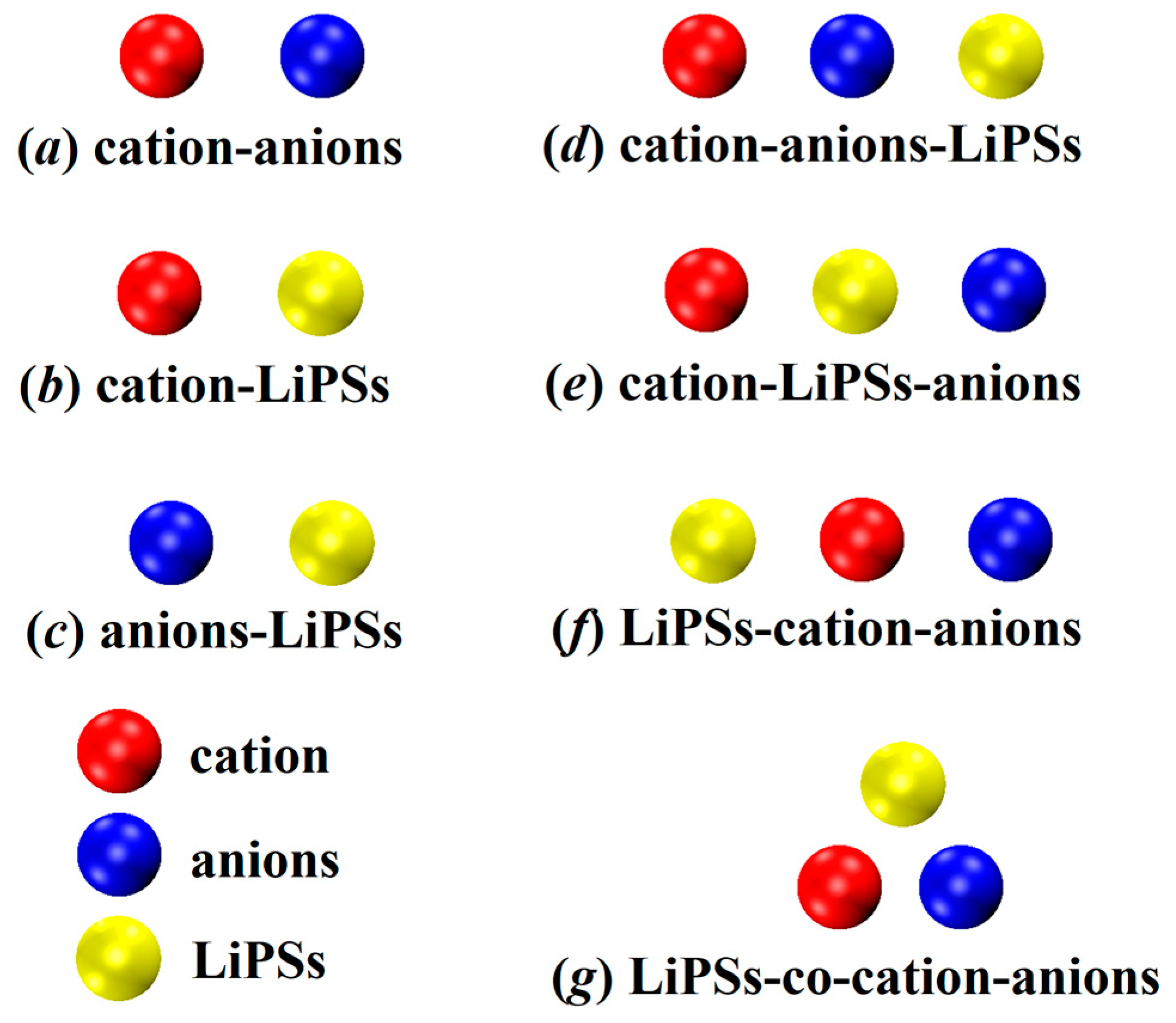


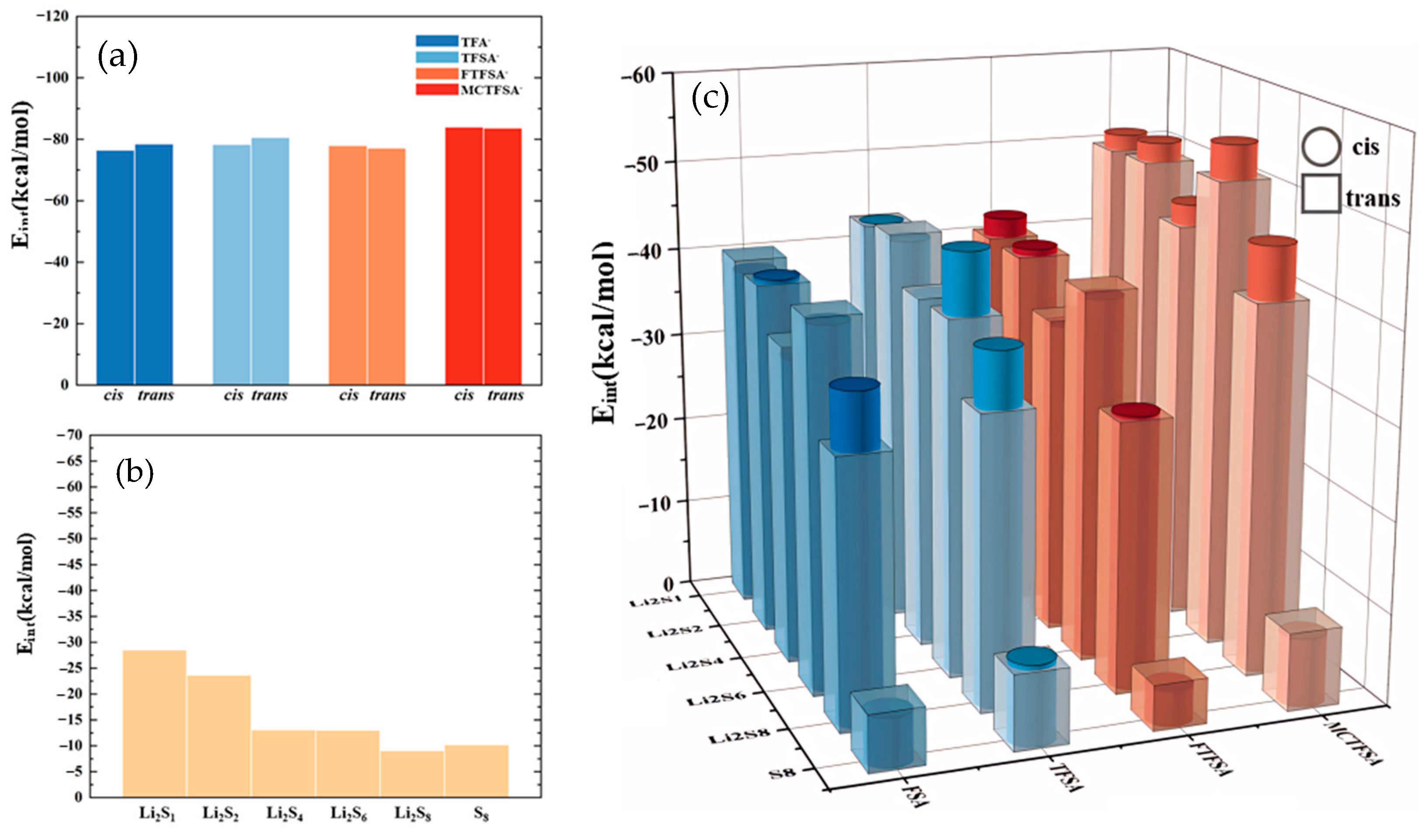





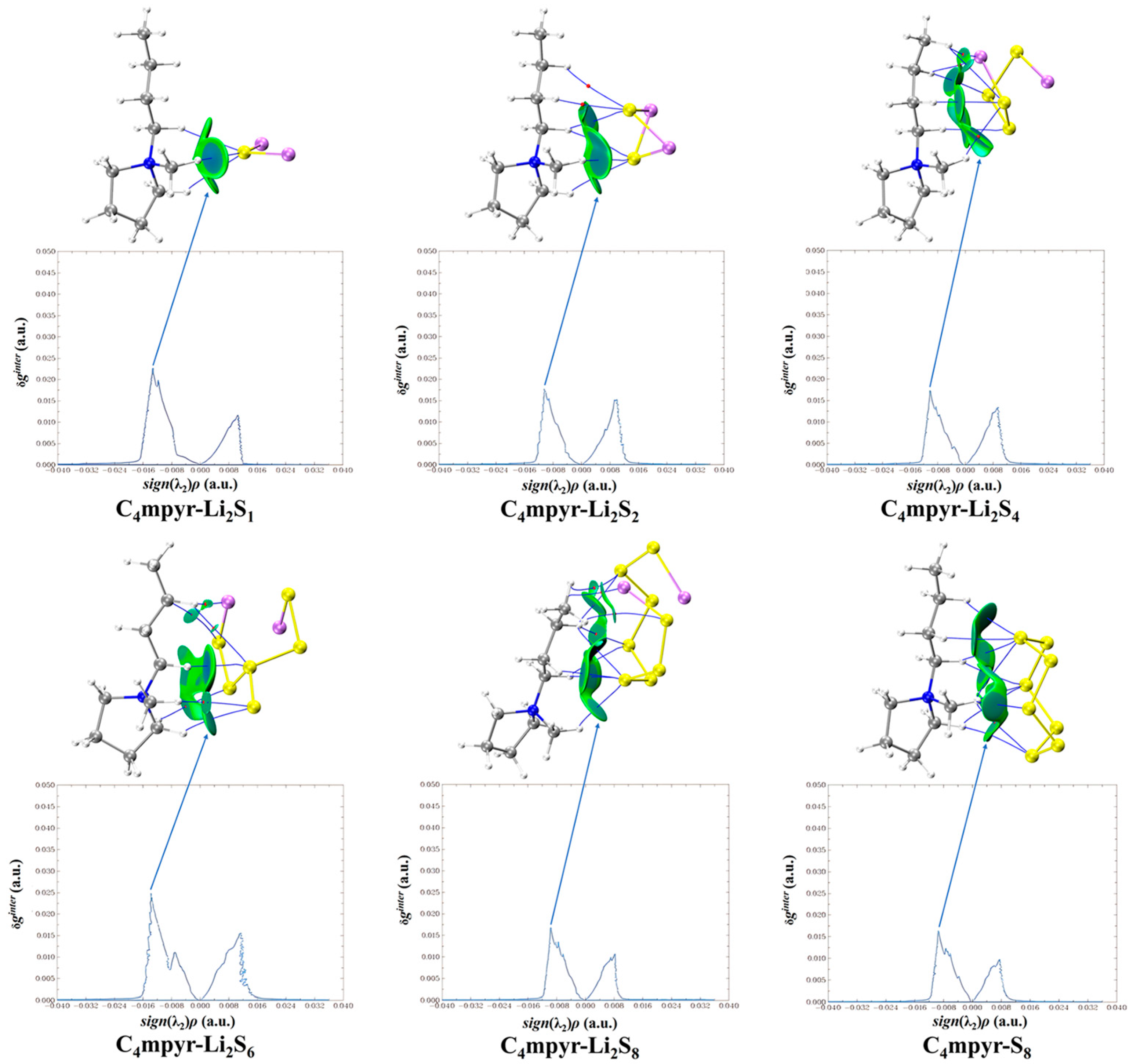
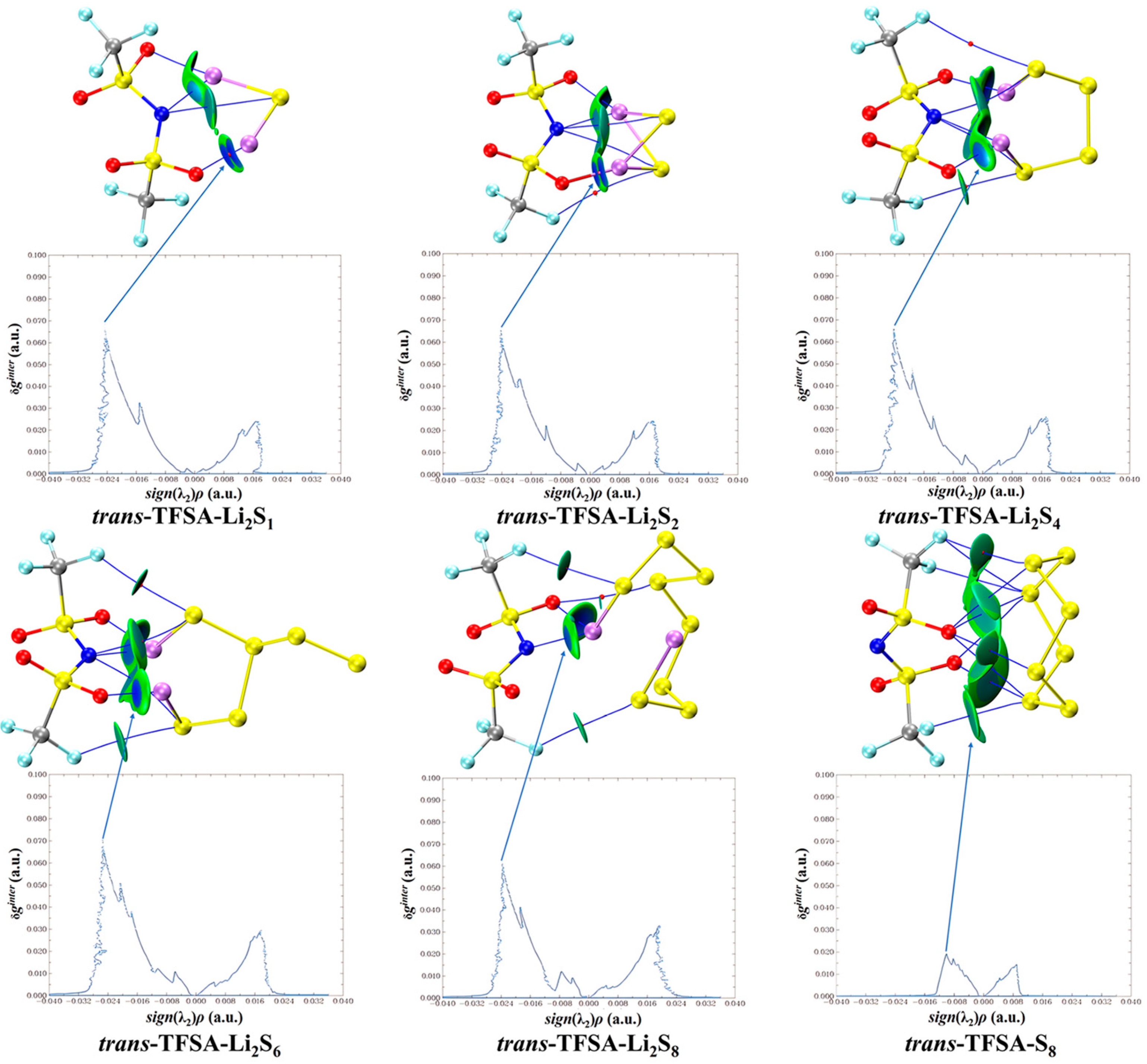
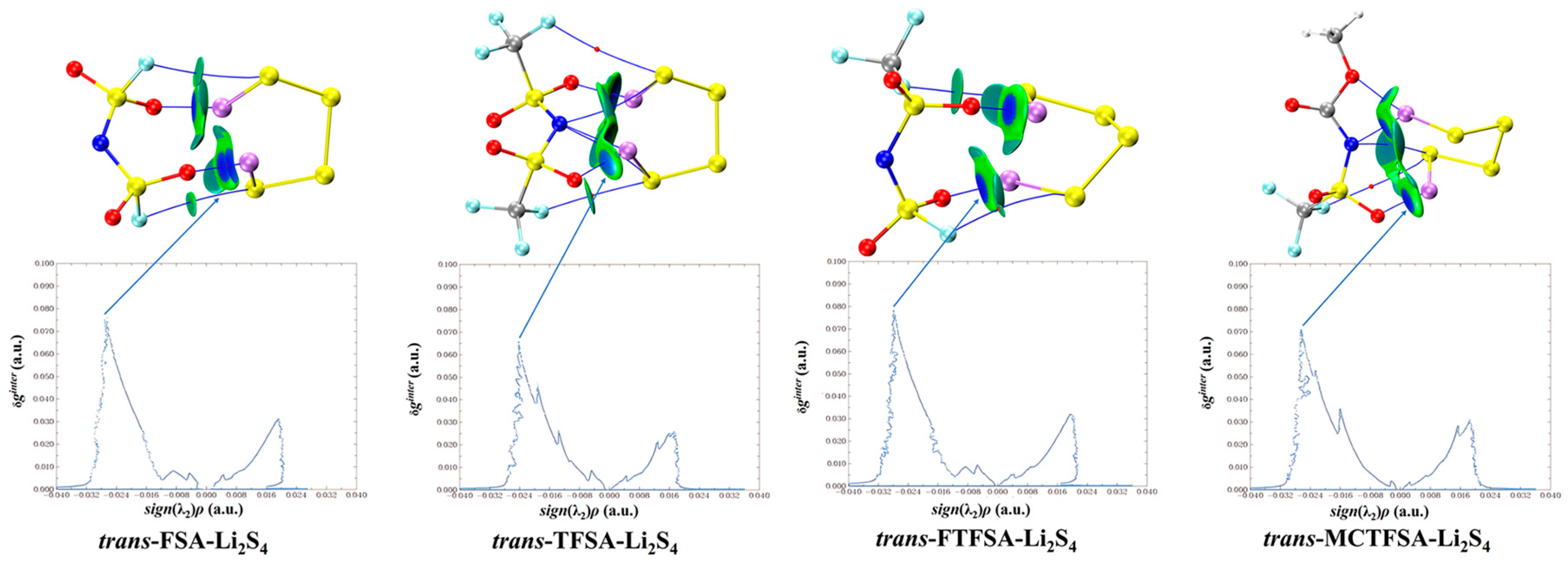


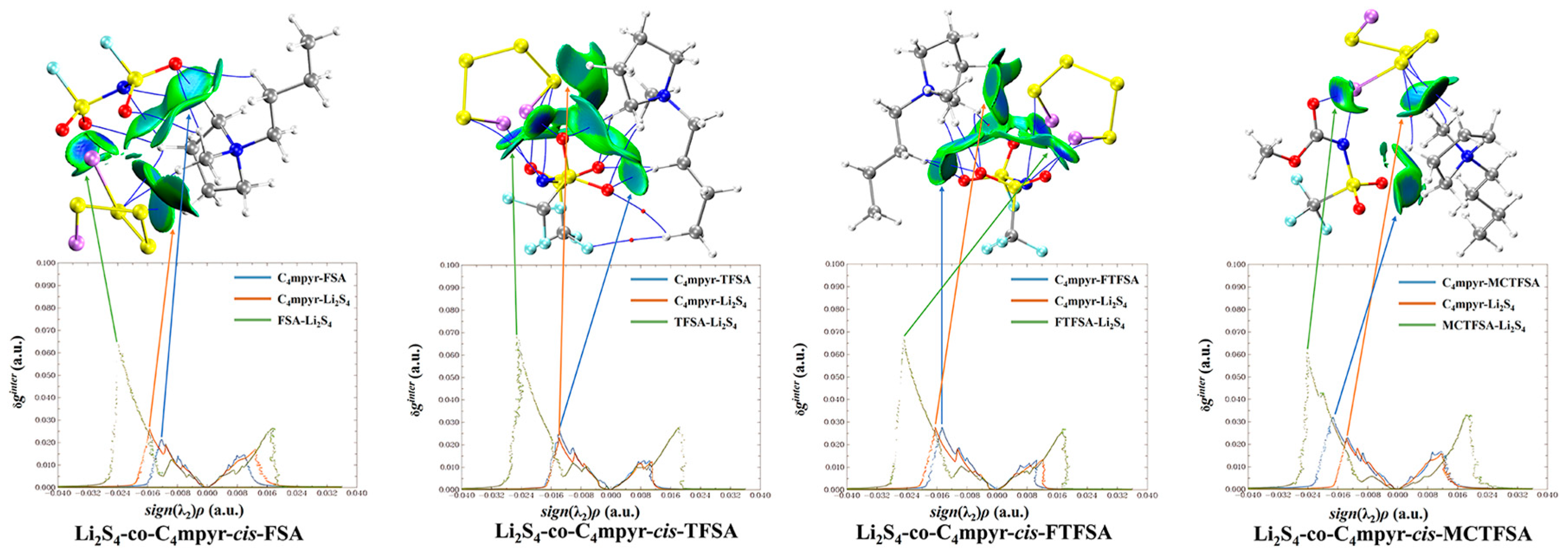
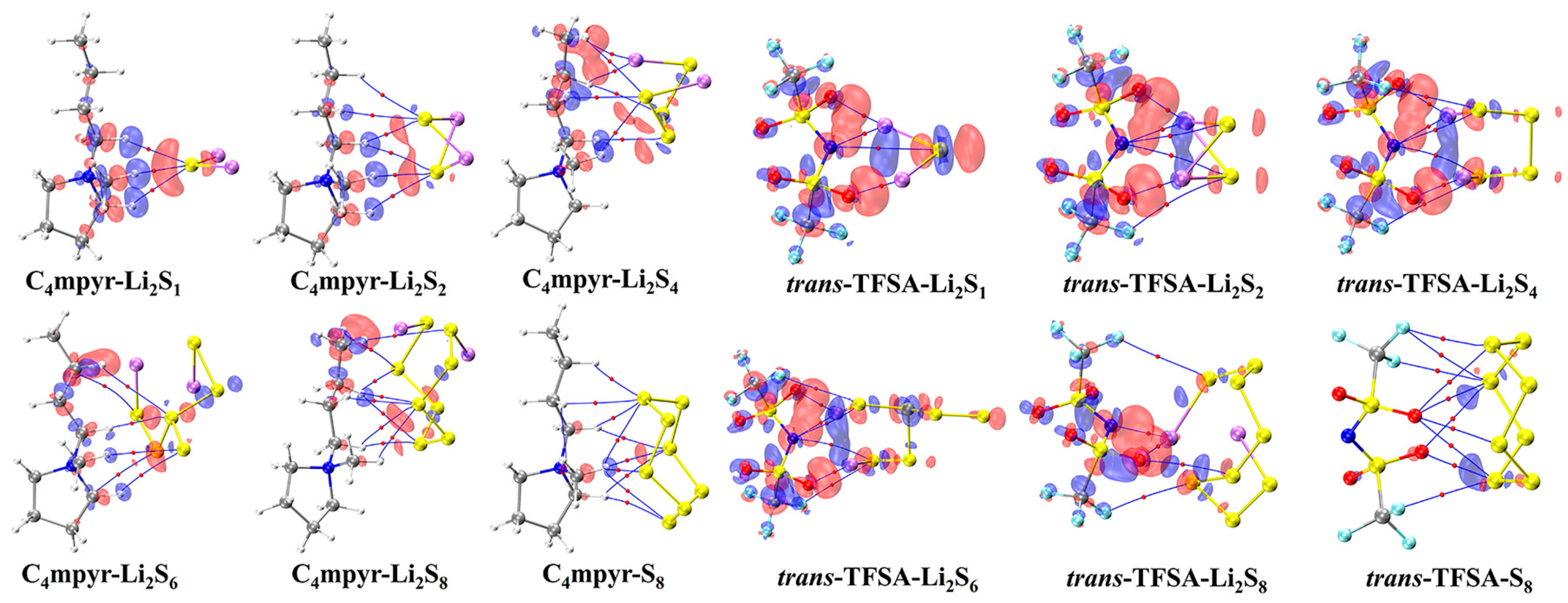
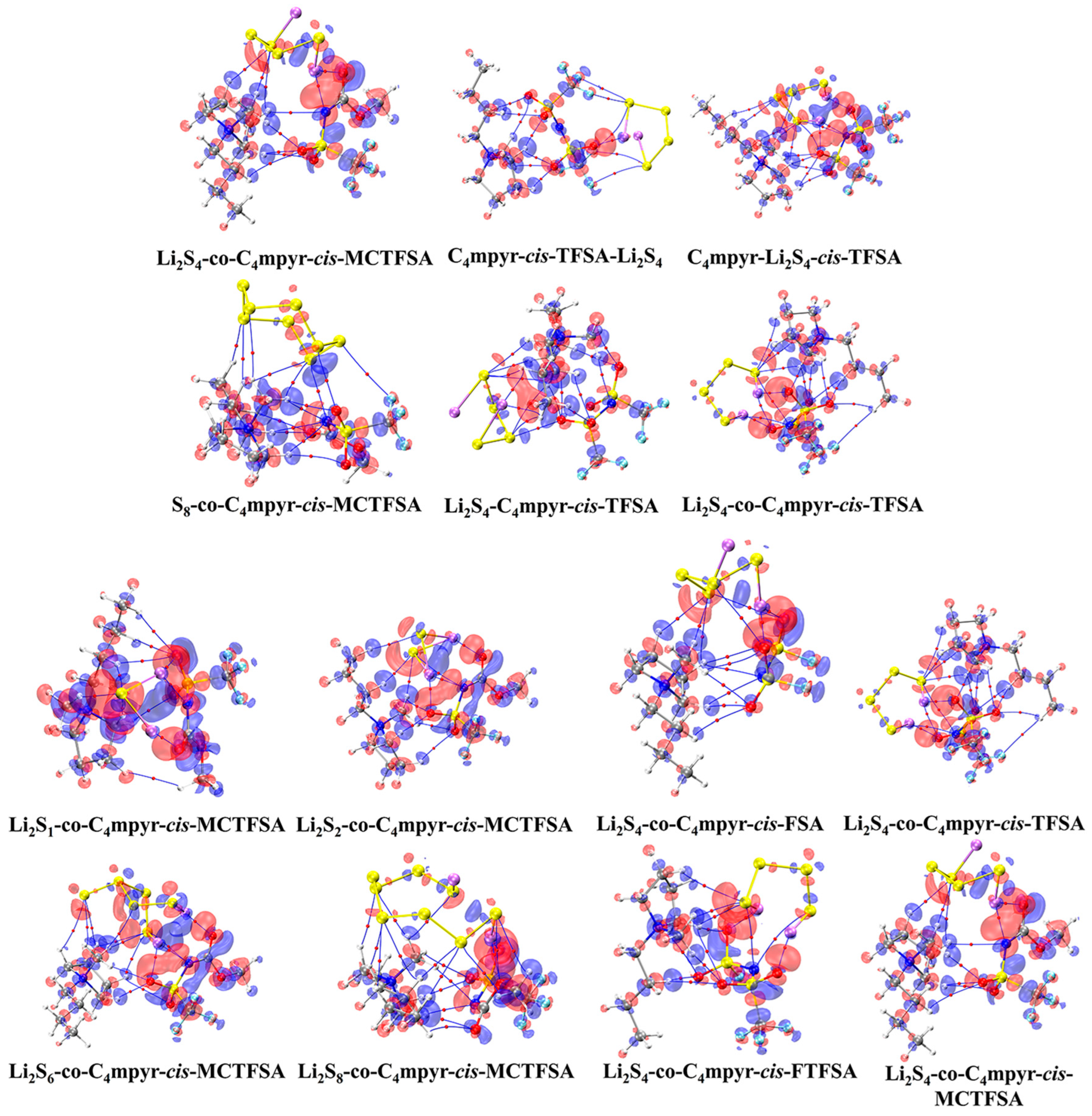
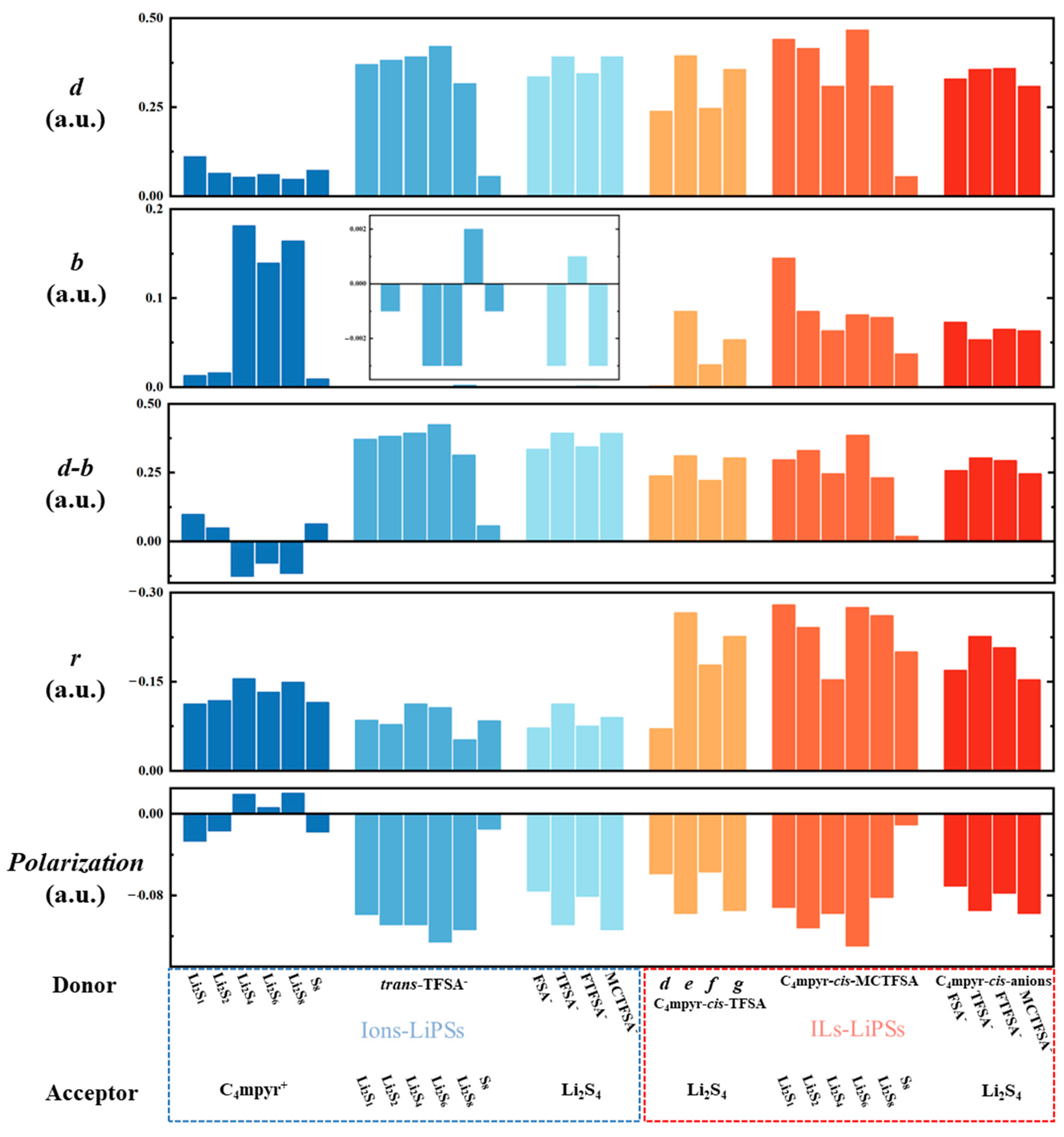

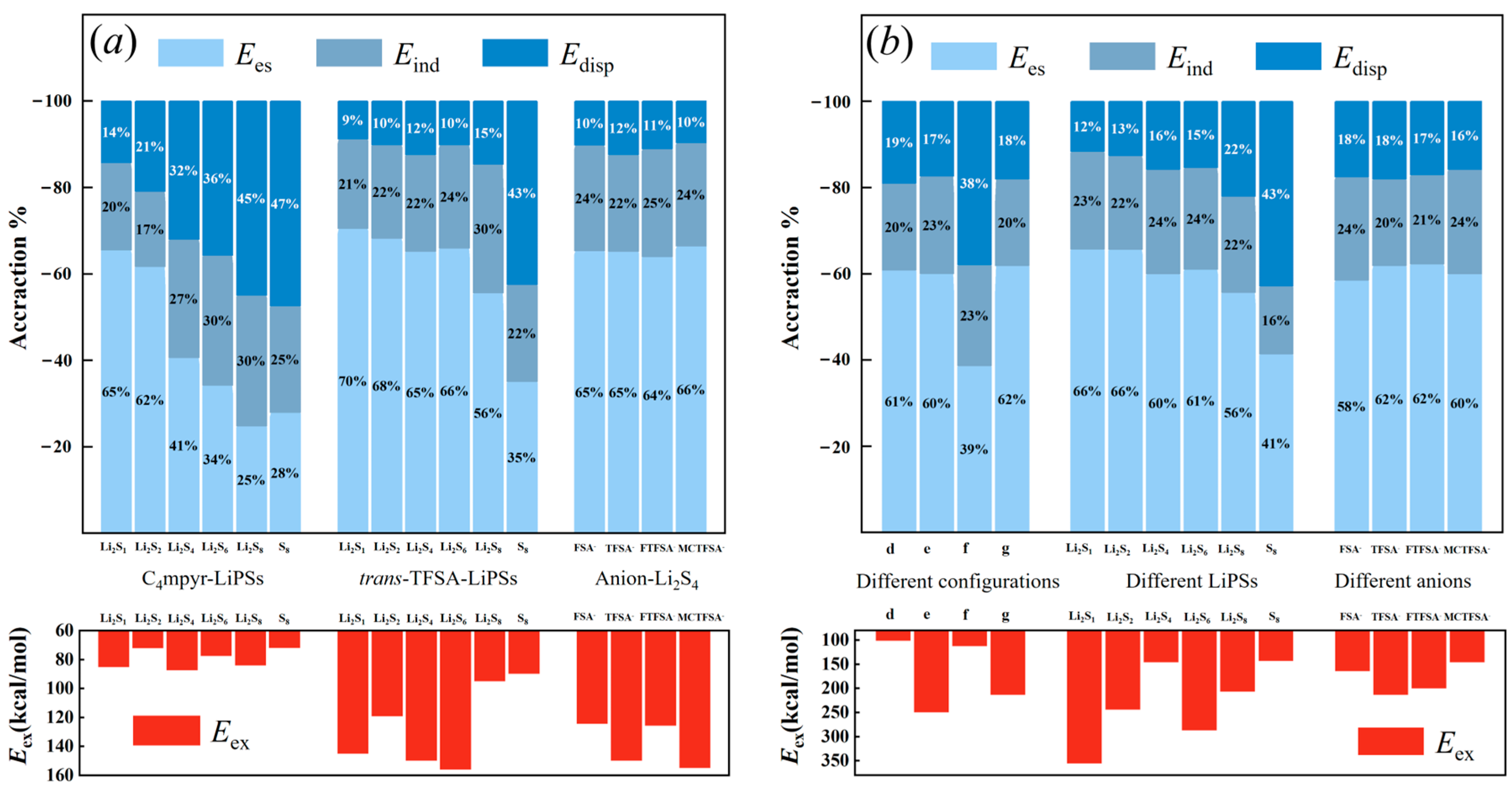
Disclaimer/Publisher’s Note: The statements, opinions and data contained in all publications are solely those of the individual author(s) and contributor(s) and not of MDPI and/or the editor(s). MDPI and/or the editor(s) disclaim responsibility for any injury to people or property resulting from any ideas, methods, instructions or products referred to in the content. |
© 2024 by the authors. Licensee MDPI, Basel, Switzerland. This article is an open access article distributed under the terms and conditions of the Creative Commons Attribution (CC BY) license (https://creativecommons.org/licenses/by/4.0/).
Share and Cite
Li, C.; Zhou, N.; Sun, R.; Tang, J.; Liu, J.; He, J.; Peng, C.; Liu, H.; Zhang, S. The Interactions between Ionic Liquids and Lithium Polysulfides in Lithium–Sulfur Batteries: A Systematic Density Functional Theory Study. Materials 2024, 17, 2689. https://doi.org/10.3390/ma17112689
Li C, Zhou N, Sun R, Tang J, Liu J, He J, Peng C, Liu H, Zhang S. The Interactions between Ionic Liquids and Lithium Polysulfides in Lithium–Sulfur Batteries: A Systematic Density Functional Theory Study. Materials. 2024; 17(11):2689. https://doi.org/10.3390/ma17112689
Chicago/Turabian StyleLi, Chengren, Nan Zhou, Rongde Sun, Jiaxin Tang, Jianglu Liu, Jianhua He, Changjun Peng, Honglai Liu, and Shaoze Zhang. 2024. "The Interactions between Ionic Liquids and Lithium Polysulfides in Lithium–Sulfur Batteries: A Systematic Density Functional Theory Study" Materials 17, no. 11: 2689. https://doi.org/10.3390/ma17112689
APA StyleLi, C., Zhou, N., Sun, R., Tang, J., Liu, J., He, J., Peng, C., Liu, H., & Zhang, S. (2024). The Interactions between Ionic Liquids and Lithium Polysulfides in Lithium–Sulfur Batteries: A Systematic Density Functional Theory Study. Materials, 17(11), 2689. https://doi.org/10.3390/ma17112689






